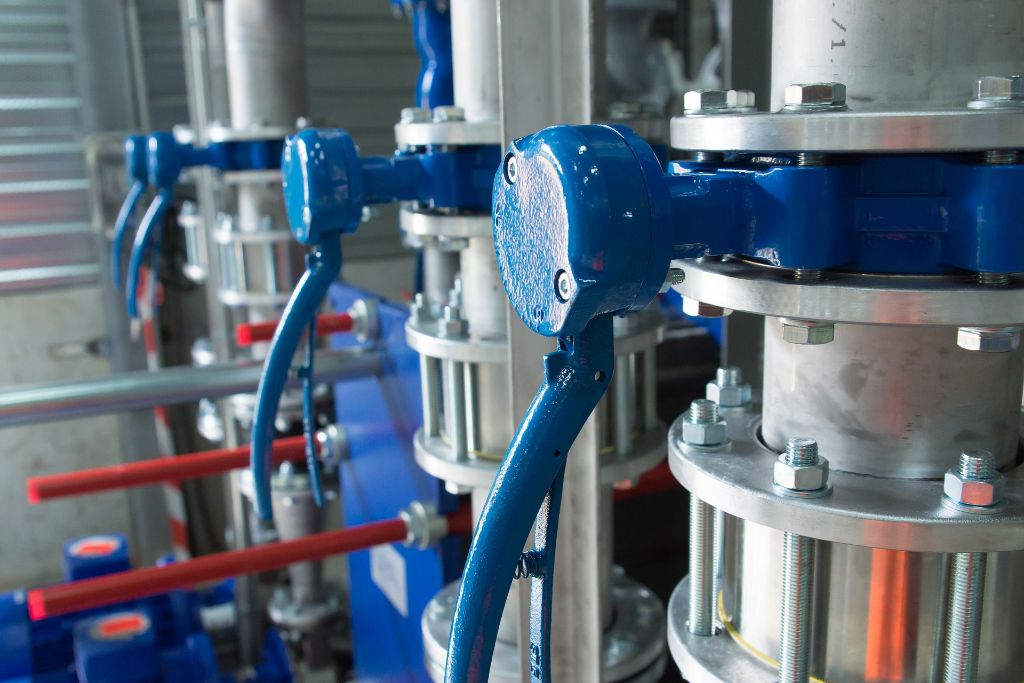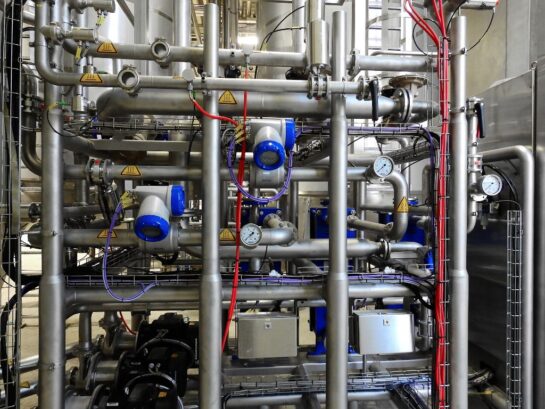Industrial firms face many uncertainties when seeking pressure testing services. Pressure testing is essential to safe and efficient manufacturing, refining, storage, and transportation of industrial goods. Inappropriate methods pose a huge risk to firms’ productivity and financial solvency. Hydrostatic testing mitigates many of the safety hazards and testing failure risks associated with other pressure testing methods [1]. In this article, we will examine the process, applications, and limitations for hydrostatic testing in industrial applications.
What Is Hydrostatic Testing?
Hydrostatic (“hydro”) testing is the most commonly used method of leak testing for piping systems, boilers, gas cylinders, fuel tanks, and other pressure vessels [2]. There are different methods of performing hydrostatic testing. All of the methods involve purging the system contents and filling the system with water to create a static pressure at or above its standard operating pressure. Then the system is inspected for visible and/or measurable leaks or deformation [3]. Some hydrostatic testing services enhance the accuracy of visual inspection during this process by adding fluorescent or tracer dyes to the water in the system [4]. This process enables technicians to identify several types of flaws. These are most notably, existing seam flaws in the material, stress corrosion cracking (SCC), linear crack-like anomalies, active corrosion cells, and poor weld integrity and/or flange fitting [2]. Because hydrostatic testing almost always involves pressurizing the line or vessel above standard operating pressure, it has the benefit of yielding a high margin of confidence in the serviceability of the system [5]. Prior to conducting hydrostatic testing, pipelines and other systems should undergo in-line inspection when possible to reduce the risk of testing failure [5].
Depending on the size and complexity of the system being tested, there are several different methods for conducting hydrostatic testing, including:
Water Jacket - This type of hydrostatic testing involves filling a small pressure vessel with water, placing it inside a water-filled test chamber (called a test jacket). The vessel is then pressurized, measuring the volume of water displaced from the test jacket by the vessel’s expansion. This is done both when under pressure and after being depressurized. Vessels that demonstrate a high percentage of expansion and/or a significant difference between their permanent and under-pressure expansion are often unfit for use [3].
Direct Expansion - Similar to the water jacket method, direct expansion hydrostatic testing involves measuring the unpressurized volume of a vessel. This is done by forcing water into the vessel to pressurize it and then measuring the amount of water expelled from the vessel when it is fully depressurized. Though this method yields the same measurements as water jacket hydrostatic testing (the percent of permanent expansion and expansion under pressure), it is less accurate. Consequently, it is not often permitted by regulatory bodies [6].
Proof Pressure - This method of hydrostatic testing has limited practical applications, especially in the United States. It does not yield any functional measurements of either permanent or under-pressure expansion percentages. Rather, it only provides information about existing failures (leaks) and wall thinning that may cause failure in the future. This process involves applying a predetermined internal pressure to a vessel then visually inspecting the system under pressure for leaks and deformation of localized thinned areas [6].
Pressure Recession - Like the proof pressure method, the pressure recession hydrostatic testing process does not yield any functional measurement of permanent or under-pressure expansion. Using water to pressurize a vessel or system the pressure supply is immediately cut off and technicians monitor the recession of the vessel’s internal pressure as the system expands. This process, in combination with a visual inspection of the pressurized system, can help identify thinning and/or deformation of the vessel walls [6].
What Are The Limitations?
Though it is the most common, most reliable, and safest pressure testing method, hydrostatic testing cannot detect all types of flaws in a pressure vessel and is not always ideal for every system. Most significantly:
Hydrostatic Testing Cannot Detect Subcritical Flaws In A System - Subcritical flaws are those that require exposure to greater internal pressure than the system is subjected to during hydrostatic testing in order to become visible/measurable [2]. Hydrostatic testing relies on visual inspection and/or expansion measurements to determine the serviceability of a system. Because of this, subcritical flaws can remain undetected during and can even be worsened by hydrostatic testing.
Subcritical flaws exposed to high levels of pressure can move closer to failure due to increased stress and can also turn into pressure reversal events. A pressure reversal is a post-testing failure event where an unidentified defect fails at an internal pressure level below the pressure level that the defect previously survived during standard operating conditions. The cause of this kind of failure is defect growth caused by exposure to increased pressure and rapid depressurization during testing [5]. This is why in-line inspection is a highly-recommended preparatory step for hydrostatic testing services.
Hydrostatic Testing Is Not Always Ideal For Retesting Existing Systems - Hydrostatic methods of pressure testing are not always the most effective way to pressure test existing systems. Primarily, this is because hydrostatic testing requires the targeted vessel or system to be temporarily taken out of service and purged of its contents [5]. The resulting downtime represents a not insignificant loss in productivity, unless the client maintains a completely separate, redundant system that can remain active during testing.
Although hydrostatic testing provides a high margin of confidence concerning the serviceability of a system, the risk of testing failure posed to older vessels and pipelines may undermine the serviceability of older systems. This is because subjecting older systems to high levels of internal pressure may ultimately cause a high number of leaks, deformities, and other testing failures that would not have occurred under normal operating conditions [5].
What Are The Industrial Applications?
Common industrial applications of hydrostatic testing include determining the integrity and informing the effective repair of:
- Fire suppression systems
- Newly installed or modified gas, water, and other-fluid piping systems
- Leads, tanks, and reactors used in industrial processes
- Heat exchangers
- Air compressor and storage and distribution systems
Hydrostatic testing is suitable for detecting material discontinuities formed during equipment casting and welding. Such flaws include shrinkage/thinning, localized hard spots, gas pinholes, gas porosity, sand inclusions, cracks, and ductile tears [7, 8]. These applications are necessary and available for manufacturing, storage, and transportation equipment across a wide variety of different industrial spaces.
What To Look For When Hiring Industrial Hydrostatic Testing Services:
The unique needs of different industrial firms ultimately determine the characteristics of their best-fit hydrostatic testing service provider. Yet industrial clients should look for hydrostatic testing services that meet the following expectations:
- The service provider is aware of and uses testing methods that comply with the standards set by industry-specific and governmental regulatory agencies.
- The service provider recommends common-sense testing failure prevention practices, including but not limited to in-line inspection and the application of alternative pressure testing methods (like ultrasonic and acoustic pressure testing) when hydrostatic testing poses unjustifiable risks to clients’ systems.
- The service provider is capable of hydrostatic testing to 60,000 PSI with flexible/adjustable pressure settings and sufficient knowledge of equipment- and material-specific specified minimum yield strength and standard mill-test pressures.
Ultimately, when seeking hydrostatic testing services, industrial firms must make hiring decisions based on the conditions of the job and the characteristics of the system to be tested. If you are interested in receiving custom recommendations based on your needs, contact Precision Fabrication & Cleaning here. We’ll be happy to help!
References:
- http://www.wermac.org/others/ndt_pressure_testing.html
- https://www.sciencedirect.com/topics/engineering/hydrostatic-testing
- https://inspectioneering.com/tag/hydrostatic+testing
- https://www.vpgroundforce.com/gb/footer-links/useful-links/industry-resources/hydrostatic-testing/
- http://citeseerx.ist.psu.edu/viewdoc/download?doi=10.1.1.565.4309&rep=rep1&type=pdf
- https://www.amazon.com/Handbook-Compressed-Gases-Association-Inc/dp/0412782308
- https://www.uraca.com/en/applications/pressure-testing/
- https://www.thomasnet.com/products/hydrostatic-testing-services-96152996-1.html

